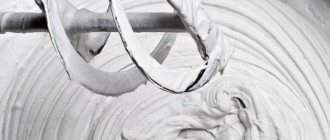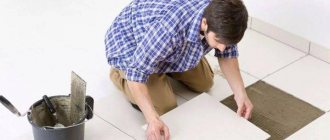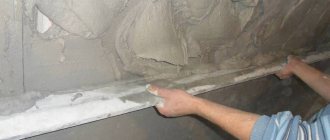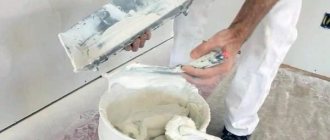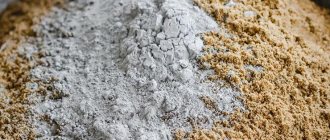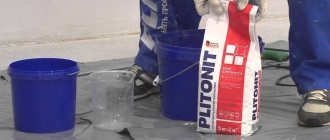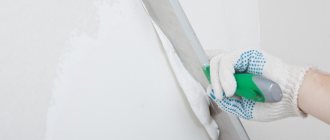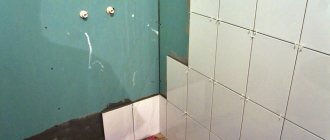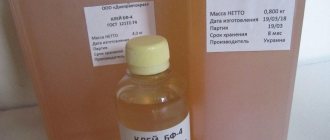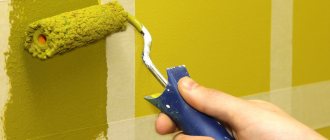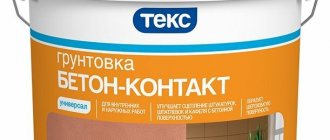The knauf group of companies has long been distinguished by the German quality of its products, which are represented by plasterboard, gypsum fiber boards, as well as dry construction mixtures, for example, rotband plaster, the characteristics of which we will consider in the article.
The main material that Knauf works with is gypsum (natural, and now also recovered from exhaust gases - REA-gips). In addition to gypsum mixtures, the enterprises produce dry mixtures with cement binder. We offer an introductory tour of the country “Rotband”.
Types and description of rotband plaster
In creating its “empire,” knauf used various ways to attract customers to its products. Thus, by analogy with brand marks on cigars in the form of paper ribbons, a red ribbon sign appeared on the packaging, symbolizing the products of one of the lines.
Hence the recognizable brand name - Rot gang - red ribbon. Under the symbol of the red ribbon, gypsum plaster dry mixtures of several modifications are now produced, developed for different conditions and purposes of use.
Once upon a time, gypsum was sold in its pure form, and plaster mortars based on it were made on site. This was due to the fact that gypsum is a “capricious” substance, it does not hesitate for a long time, and tends to harden quickly. In addition to this haste, gypsum is also characterized by the ability, by absorbing water from the air, to turn into “crackers”. Therefore, if you store it for a long time without protecting it from atmospheric moisture, you can get raw materials unsuitable for use.
For the industrial production of SS (dry plaster mixtures), the invention of a retarding substance, as well as the production of moisture-proof packaging, became a condition for the appearance. All that’s left to do is to develop a recipe for a composition that has certain properties according to the purpose.
Gypsum plaster has three such purposes (for each, its own mixtures have been developed):
- technical (serves to level the surface of the base, seal joints, seal cracks, spalls);
- decorative (used to decorate the interior);
- protective (protects the materials of walls, ceilings, partitions from external influences, softens fluctuations in humidity or temperature, ensuring the comfort of residents).
Terms of use also vary. The instability of gypsum to moisture limits the use of mixtures based on it in the interior. That is, gypsum-containing plaster mixtures are unsuitable for facades.
They are limitedly suitable for such premises as a bathroom, unheated buildings, unglazed loggias. However, Knauf specialists tried their best - they created mixtures that are more resistant to water.
By the middle of the twentieth century, plastering machines/stations appeared that required special grinding quality and a special composition of mixtures that did not stick to the surface of the working equipment. According to the request, SS for plastering using machines appeared in the company’s line.
Advantages of Rotband
The main advantage of Rotband gypsum plaster, the price of which is affordable and even democratic, is that it is produced at Russian enterprises, albeit with the involvement of German funds. It should be noted that you can buy it without any problems, and it is packaged in 5, 10 and 30 kilograms. Not only specialists can cope with the work, and their services are expensive, but also beginners, and this can also be attributed to the advantages of Rotband.
GS Rotband can be called a universal finishing material, since it can be used to finish any surface, and this is evidenced by numerous positive reviews about it. The material contains not only gypsum, but also special additives that increase the degree of adhesion of the material. Universal gypsum plaster Rotband is recommended for use both in rooms with normal humidity and in technical rooms, in the kitchen and bathroom. It is used to work with hard bases such as brick and cement plaster, but especially good results can be achieved when facing smooth concrete walls.
Rotband plaster technical characteristics
The user is primarily interested in the technical characteristics of the material. The quality of the plaster coating, its reliability, and trouble-free operation depend (largely) on them.
Table 1. Rotband plaster: characteristics
| Characteristic | Magnitude | Unit measurements | ||
| Density | SS | 730 | Kg/cub.m | |
| Dry plaster coating | 950 | |||
| Coating strength | Bend | >1 | MPa | |
| Compression | >2/5 | |||
| Deadlines | Maturing the dough | 10 | minutes | |
| Life solution | up to 25 | |||
| Drying layer 10 mm | 45-60 | |||
| Achieving full strength | 7 | days | ||
| Allowable layer thickness | min | 0.5 | cm | |
| recommended | 1.0 | |||
| max | walls | 5.0 | ||
| ceiling | 1.5 | |||
| Gypsum grain size | 0.2 — 1.2 | mm | ||
| Consumption at h=10mm | 8.5 | kg/sq.m | ||
| Output of solution from 1 package (30 kg) | ~ 40 | l | ||
| Temperature conditions for plastering | from 5 to 30 | оС (above zero) | ||
| Shelf life | until 6 | months | ||
| Plaster color | white, pinkish, gray | — | ||
Shelf life and storage conditions
The packaging indicates the production time of the material. Starting from there, the expiration date is counted. If the manufacturer guarantees the preservation of the original qualities for at least six months (6 months), then such shelf life can be expected only if the packaging is intact, as well as with proper storage.
Powdered formulations are stored:
- in non-residential premises;
- at normal humidity;
- no sunlight on the packaging;
- away from heating devices, but at room temperature;
- in a tightly packed bag;
- with natural ventilation.
Ready formulations are stored under the same conditions. The container is hermetically sealed. Expired rotband plaster, the characteristics of which were partially lost due to a long shelf life, becomes unsuitable for plastering in residential premises or offices.
You can check suitability by diluting a small amount and applying it to a sample in an area where quality is not critical.
Experts do not recommend diluting expired plaster by mixing it with good quality plaster. When mixing old (expired) and new (usable) plaster, only the old one is obtained.
Compound
To avoid counterfeiting, the composition of the SS and the finished dough produced by the company is not disclosed. It is known that the composition contains a finely dispersed gypsum mixture, a number of mineral components that give the mixture elasticity, the ability to retain moisture, and increase adhesion. Components have also been added to reduce cracking and shrinkage.
Application
The finished materials are mixed before use. Apply with a spatula or trowel (depending on the purpose of use). SS is diluted with water no higher than room temperature. The dilution procedure and proportions are specified by the manufacturer.
Some nuances worth mentioning:
- The need to use a clean container (if gypsum gets in contact with even a lump of solution that has begun to dry out, it can suddenly set in its entire volume ahead of schedule).
- Take only tap water (clean), preferably cold, since warm water shortens the lifespan.
- Tools should be regularly cleaned of the solution by wiping with a damp cloth or washing.
- A separation barrier is needed between the gypsum mortar and the cement/concrete base.
Rotband machine plaster compositions can be used for manual application, but not vice versa. Descriptions of machine and manual application are given in the Plastering section.
Layer thickness
It is known what “heights” deviations of walls from the vertical or from the plane in general can reach. Therefore, sometimes even the allowed maximum thickness of the plaster layer – 5 cm – does not help.
In such cases, the following leveling technology is used:
- apply a maximum layer (50mm);
- allow the solution to dry completely;
- prime the surface twice (as required according to the instructions);
- Apply a layer of the missing thickness (up to 5 cm).
The minimum thickness must also be observed. For Rotband it is 5 mm. The permissible maximum depends on the location of application: ceiling surfaces require a layer of no more than 1.5 cm, for walls the maximum is 5 cm. It is optimal to gain the total thickness according to the above scheme with a layer thickness of 10-15 mm.
Release form
Two forms of plaster compositions have been developed and are produced - ready-made dough and dry mix. The dough is packaged in plastic buckets, starting with a capacity of 5 liters, ending with a capacity of 20 liters. Ready-to-use paste should not be left open for a long time.
The second form is more popular - loose mixtures diluted with water before use. The manufacturer uses special paper bags or plastic bags for packaging. The first SS is filled with 5 to 30 kg, the second - only 5 kg.
The packaging is protected against counterfeiting:
- in paper containers, special paper is used for the top layer, on which protective stripes are applied by embossing;
- the date of production of the plaster composition is indicated to the nearest second;
- a hologram is placed on the front side of Kraft bags weighing 5 and 10 kg;
- on the front side of the 25-30 kg packages there is a stamp indicating that the quality has been checked and that the plaster mixture complies with the German standard (see picture).
In addition to the voiced (advertised) methods of defense, Knauf uses unadvertised ones. These methods are known only to company representatives. Therefore, if you doubt the authenticity of the product, contact knauf representatives.
Color
In nature, gypsum raw materials in deposits can differ in composition, which ultimately determines the color of the plaster mixture. Knauf processing plants located near a specific deposit produce CC with a hint of natural raw materials. Therefore, there are three varieties of color and transitional shades:
- pink;
- white of varying degrees of purity, for example, produced in Astrakhan;
- grey.
The influence of color on the quality of the working solution has not been clarified. Some argue that white grout tends to run down the wall more, while others attribute this behavior to pink or gray grout. The manufacturer does not indicate the color of the mixture, which means there should be no effect on performance.
A pink tint can be given to the mixture by the presence of red clay particles, for example, in the production of SS from Chelyabinsk deposits. Clay particles give the solution greater plasticity, but also give the form greater stability. Organic matter can impart shades of gray, an admixture of manganese or iron provides some yellowness, and an admixture of silt makes it green.
The color of the plaster, for example, pink, can show through thin wallpaper or putty. In this case, you should purchase white mixtures. Under other circumstances there is no difference.
Fraction size
Gypsum enters the SS in a ground state. The workability and roughness of the resulting surface depends on the size of the fractions. The permissible size is no more than 1.2 mm. However, it turns out that the granularity of the raw material also depends on the properties of natural gypsum.
So in Kolpino they produce mixtures with grains of 1 mm, and in Chelyabinsk and Krasnogorsk gypsum grains containing up to 0.5 mm are produced. This plaster allows you to obtain surfaces suitable for painting or plastering under thin wallpaper. Decorative plaster or leveling under tiles is best done using coarser compounds.
Drying time
After mixing, chemical processes begin to occur in the mixture associated with the release of ions, the formation of a solution, followed by crystallization. The beginning and course of each stage of the process has a time frame.
Therefore, the following time periods are distinguished:
- maturation (semi-aqueous gypsum after mixing turns into the form of aqueous gypsum) - duration 10 minutes;
- being in an open container, the composition retains its plasticity and the consistency of a semi-liquid mass - lasting up to half an hour;
- rapid setting with loss of plasticity separates this phase from the previous one;
- drying of a layer of minimum thickness occurs according to the room conditions and lasts several hours;
- The moisture remaining in the thickness of the layer is spent on the formation of additional bonds, hardening of the coating (the solution is immobile, but is easily destroyed even by a small load), it takes a week to completely dry.
Subsequent finishing work can be carried out after a week of drying.
Strength
The resistance of a plaster coating to external pressure depends on its strength characteristics. Specific data can only be obtained through laboratory tests. Knauf guarantees that the plaster composition will gain a bending strength of at least 1 megapascal, and a strength of at least 2.5 megapascal.
This applies only to coatings created without violating the instructions. In other words, the coating will remain intact at a pressure per centimeter of surface force of 25.5 kg.
Plastic
This quality allows you to create unique decorative coatings, perform leveling in hard-to-reach areas, seal gaps in joints tightly, without creating voids, and cover “recessed” screw heads on the surface of drywall.
The ability of the plaster mass to easily fill cracks, lay down a layer of the required thickness, and be responsive to the slightest movement of the tool depends not only on the size of the fractions of the components of the composition, but also on additives - natural mineral substances and synthetic modifiers. Rotband plaster has characteristics that distinguish it from its competitors by its high ductility.
Adhesion and density
The ability of gypsum to “adhere” to various bases is enhanced in Rotband compositions. The mass lies and holds firmly on concrete, old plaster, metal, wood, brick. Experts especially recommend Rotband mixtures for plastering drywall. Rotband is also suitable for plastering porous materials (provided the pores are clogged with primers).
Water holding capacity
When creating coatings from solutions with a gypsum base, the pores of the base must be plugged so that moisture is not drawn out of the solution by the voids. Uneven dehydration of the drying solution reduces the strength characteristics of the created coating. It is better to use company-branded products for priming.
Frost resistance, moisture resistance, vapor permeability
Rotband plaster forms finely porous coatings that can absorb vapors from the air, returning them when the dryness in the room increases, thereby creating a comfortable microclimate. By allowing air to pass through, the gypsum finish allows the wall materials to breathe freely.
The third property, frost resistance, is not required in heated rooms. It is important if glazed loggias are plastered with rotband. The composition is capable of withstanding up to 75 (or more) freeze-thaw cycles without destruction.
Rotband is also used for plastering rooms such as bathrooms, kitchens, and toilets. True, for this purpose a number of measures are taken to prevent the direct flow of moisture to the plaster. For example, they apply a waterproofing film, plaster only some areas, and protect the plaster layer with tiles.
Thermal conductivity
Fine-pored gypsum material, due to its smaller structure, helps retain heat. The thermal conductivity of Rotband (0.25 W/m x deg) is lower than the corresponding indicator of the cement material (0.9). As the layer thickness increases, heat retention increases.
Resistance to various factors
Gypsum has long been valued for its resistance to various influences. For example, in dry conditions, gypsum coating copes with temperature fluctuations that are not to the taste of insects, does not melt at high temperatures, and does not burn.
Consumption
The consumption of rotband plaster indicated by the company (provided that the layer thickness is maintained - 10 mm) per square meter is 8.5 kg. In practice, consumption may vary slightly. It depends on the evenness of the surface, the level of skill of the plasterers and losses during the work process. When purchasing raw materials, you should increase the consumption rate by 15-20% so that there is an “emergency” reserve.
What may be needed for plastering walls, ceilings or slopes
To prepare the working surface and carry out plastering work, you will need the following materials, tools and equipment:
- Cement;
- Primer for walls;
- Primer roller;
- Mixing container;
- Drill and mixer attachment;
- Steel spatula for leveling;
- Rule-level for smoothing and determining the evenness of the surface;
- Beacon profile;
- Trowel-ladle;
- Reinforcing plaster mesh;
- Scraper and grater;
- PVC gloves.
Approximately 75% of the quality of the plaster depends on how carefully the work was done to prepare the working surface and on how correctly the mortar was mixed!
List of sources
- remontkvartiri.me
- workerstroy.ru
- StroikaDialog.ru
Application area
Internal work is rightly considered an important area where Knauf plaster is used, since the conditions of heated rooms are less traumatic for gypsum coatings. But there are compositions that, under certain conditions, are also used for street finishing.
Waterproof plasters produced by Knauf are used to level bases in places where humidity fluctuates, reaching values above average.
In addition to technical purposes, Rotband Knauf is used for decoration (for example, they create beautiful bas-reliefs). It is not rational to add color to the rotband, since after drying the color fades greatly, and painting a relief pattern is a feasible and exciting task. Based on Knauf plaster, you can “knead” a structural dough according to your own “recipe”, adding decorative and structure-forming components - fibers, granules, quartz sand.
Useful tips
There are some points that must be taken into account when working with the mixture. For example:
1. If you decide to treat a wall made of foam plastic or chipboard, then apply the plaster in 2 layers, and lay a fiberglass mesh between them.
2. Decide in advance where you will put the remaining solution.
3. After completing the work, wash all tools as quickly as possible.
4. For final hardening of the material, you should wait at least 7 days. In this case, the room should be ventilated, but drafts should be avoided.
5. Porous surfaces are pre-treated with a deep penetration primer.
6. If there are metal elements on the wall, then clean them and paint them with a special protective mixture that will prevent rusting. Otherwise, red spots will appear on the surface that you will not be able to remove.
7. When using “Rotband” in rooms with high humidity, the surfaces must be treated with a special waterproofing agent.
That's all the features of working with the presented material. Good luck!
Gypsum analogues
A close analogue of Rotband is Volma gypsum plaster. You can also replace the rotband with the SS “Rotgips”, “Perfecta” or “Prospectors”. However, German quality has proven itself better than any advertising.
A close analogue of Rotband is Volma gypsum plaster. You can also replace the rotband with the SS “Rotgips”, “Perfecta” or “Prospectors”. However, German quality served better than professional advertising.
The popular Rotband plaster, the characteristics of which are discussed above, is recognized as the number one brand on the plastering market. It’s pleasant and easy to work with, and its technical specifications are maintained regardless of the country in which it is produced. By choosing Rotband for repair, you have already achieved half the successful result.
Briefly about the main thing
If Rotband Knauf plaster mixture is chosen to level the walls or ceiling in the house, the consumption per 1 m2 will please you with its economy. In the hands of an experienced craftsman, this plaster replaces both the starting and finishing mixture, completely preparing the surface for decorative finishing. It is environmentally friendly, as it consists of gypsum and harmless polymer additives, is easily applied to any base, and during operation helps maintain normal air humidity in the house. Its only drawback is that the solution sets quite quickly after mixing, which complicates the work. Therefore, it should be performed by professionals.
Ratings 0
